
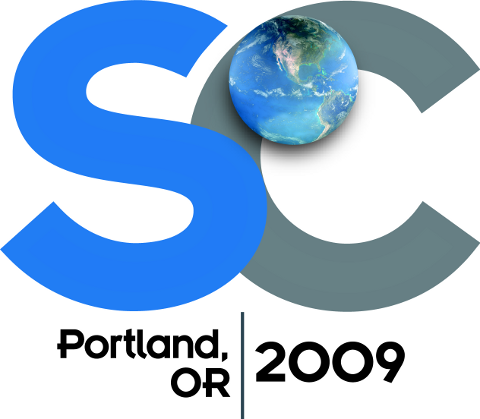

This is the home page for our 16th major research exhibit at the
IEEE/ACM Supercomputing conference. The exhibit is again under
the title Aggregate.Org / University of
Kentucky, the informal research consortium led by our
KAOS (Compilers, Hardware Architectures, and Operating Systems)
group here at the University of Kentucky's Department of
Electrical and Computer Engineering.
A Maze Of Twisty Little Passages

Much like last year, the physically big thing in our exhibit
this year is a technical demonstration consisting of a large
wooden maze with four balls in it. Each of the colored balls
has a different path to take (MIMD), yet it is perfectly
feasible to get all the balls to their respective destinations
by a series of tilts of the table (SIMD). Yes, you really can
execute MIMD code on SIMD hardware with good efficiency...
Click on the maze above for a ~50MB video showing the
maze in action.
Fundamentally, this is what our latest software does for GPUs (Graphics
Processing Units). Specifically, it can take shared-memory MIMD
code written in C and efficiently execute it on an NVIDIA CUDA
GPU.
Why do this? GPUs thus far have not had stable, portable,
programming support for general-purpose use, so there is
virtually no code base for supercomputing applications. Our
technology allows codes written for popular cluster and SMP
target models to be used directly. We plan to support both C
and Fortran with both shared memory and MPI message passing. The
current shared memory model uses "parallel subscripting" in
which a[||b] means a in processor b's
memory; we initially assumed OpenMP would be the prefered model,
but have had requests for Posix Threads. It is surprisingly
easy to support dynamic thread creation, although there are
performance issues involving memory bank conflicts in sharing
the complete memory map.
How well does MIMD code perform? A
lot better than it did last year. In fact, even
the MIMD interpreter is fast enough to be usable for real
applications.
Work Presented
The very wide range of topics emphasized in our exhibit is
summarized in the following white papers, which are available as
"print on demand" hardcopy from our research exhibit, booth
2273, at SC09:
-
A Maze Of Twisty Little Passages
(about the MIMD On GPU -- MOG -- work we are doing)
The following are the key publications for understanding our
MIMD-on-SIMD technology; the first two from the original concept
and the last giving details of the current MOG system:
-
H. G. Dietz,
"Common Subexpression Induction,"
Proceedings of the
1992 International Conference on Parallel Processing,
Saint Charles, Illinois, August 1992, vol. II, pp. 174-182.
(Postscript or
PDF)
-
H. G. Dietz and G. Krishnamurthy,
"Meta-State Conversion,"
Proceedings of the
1993 International Conference on Parallel Processing,
vol. II, pp. 47-56, Saint Charles, Illinois, August 1993.
(Postscript or
PDF)
-
H. G. Dietz and B. D. Young,
"MIMD Interpretation on a GPU,"
22nd International Workshop on
Languages and Compilers for Parallel Computing,
University of Delaware, October 8, 2009.
(local PDF copy pending Springer LNCS publication)
-
You Can't Always Get What You Want
(about Line Associative Registers vs. conventional cache,
lots of new work on this)
-
See & Hear, Show & Tell
(about digital imaging using light, sound, etc. - see Digital Imaging Technologies,
including new work on computational photography)
-
Small Thinking
(about Nanocontrollers - Kentucky Architecture, Nanoprocessors, & Nanocontrollers)
-
Horseshoes and Hand Grenades
(about precision and accuracy - Numerical Precision, Accuracy, and Range)
-
Powerful Beyond Dissipation?
(about predictive power management - Energy Management)
-
Come Together Right Now Over Me
(about Aggregate Function Networks -- Theory, Software, and Hardware --
the new work here is on-chip AFNs for CMPs)
-
Flat Outperformance
(about Flat Neighborhood Networks - NetWires)
Some related theses from our group:
-
Diego A. Rivera Polanco,
Collective Communication and Barrier Synchronization
on NVIDIA CUDA GPUs (PDF),
University of Kentucky MSEE Thesis,
September, 2009.
-
Bobby Dalton Young,
MPI Within A GPU (PDF),
University of Kentucky MSEE Thesis,
http://hdl.handle.net/10225/1085,
July, 2009.
-
Soohong P. Kim,
Chip Multiprocessors with On-Chip Aggregate Function Network,
Purdue University PhD Dissertation,
(unofficial local PDF copy pending Purdue posting),
August, 2009.
-
Akil Kaveti,
HDL Implementation and Analysis of a Residual Register
for a Floating-Point Arithmetic Unit
(PDF),
University of Kentucky MSEE Thesis,
http://hdl.handle.net/10225/893,
2008.
-
Sarojini Priyadarshini Rajachidambaram,
Kentucky's Adapter for Parallel Execution and Rapid Synchronization
,
University of Kentucky MS Thesis,
http://hdl.handle.net/10225/709,
2007.
-
Swetha Mitta,
Kentucky's Adapter for Parallel Execution and Rapid Synchronization
,
University of Kentucky MSEE Thesis,
http://hdl.handle.net/10225/621,
2007.
-
Chenxing Wang,
Dynamic Voltage Scaling for Priority-Driven Scheduled Distributed Real-Time Systems
,
University of Kentucky PhD Dissertation,
http://hdl.handle.net/10225/747,
2007.
-
Timothy Ian Mattox,
Exploiting Sparseness of Communication Patterns for the
Design of Networks in Massively Parallel Supercomputers
(PDF),
University of Kentucky PhD Dissertation,
http://hdl.handle.net/10225/280,
2006.
-
Krishna Melarkode,
Line Associative Registers
(PDF)
University of Kentucky MSEE Thesis,
http://hdl.handle.net/10225/255,
2004.
Slow-Update Live View of our Exhibit
The following image was grabbed from a network camera with a 175-degree
fisheye lens (door peephole) mounted on
the top of our 16-foot-tall sign:

After-Show Stuff
Now that the show is over, here's a little about what we did
and what we learned:
-
The Theme. Forget about being green (the
official theme). This was the year that every machine seemed to
have a few Tesla GPUs in it.
-
Most surprising thing. The "deep-fried"
computing display using oil bath cooling in a rather industrial
steel tub (see http://grcooling.com/). It is messy, but possibly
a very good idea....
-
Research? SC online registration still doesn't
understand the concept of student exhibitors. Overall, the
quantity of actual researchers in research exhibits continues to
go down... which is a very sad thing.
Some photos of our exhibit:
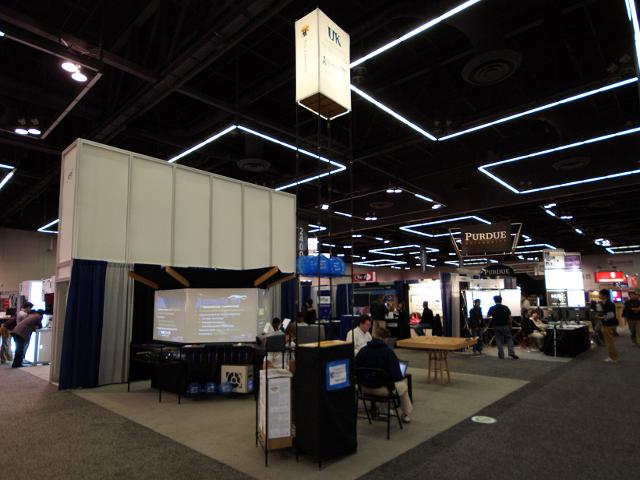
The booth overall (our tall backlit sign was visible from a good distance away)
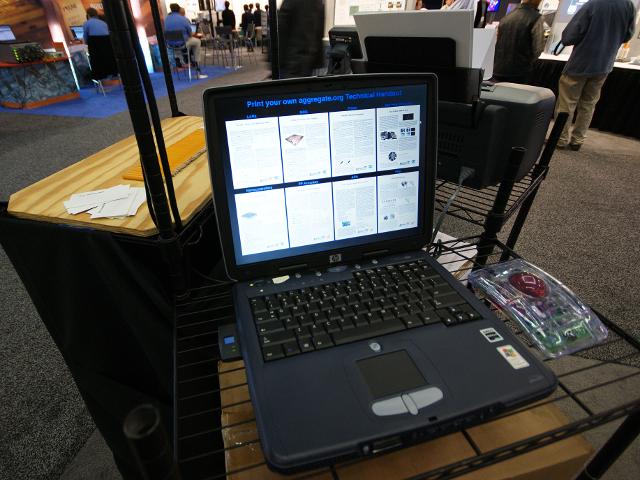
Our environmentally-friendly print-on-demand handouts
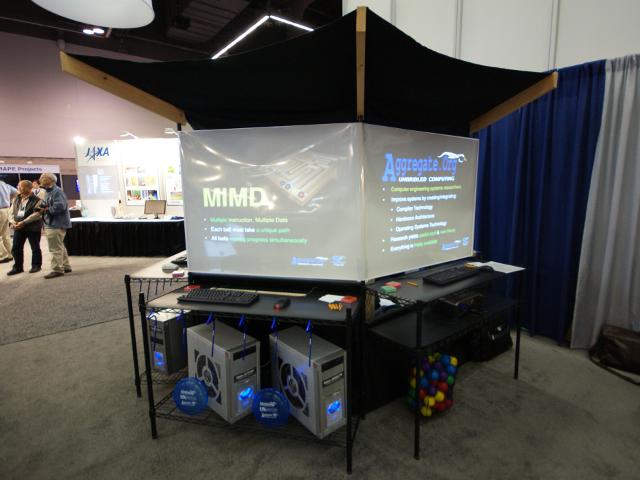
The technical and overview slides (rear projection)
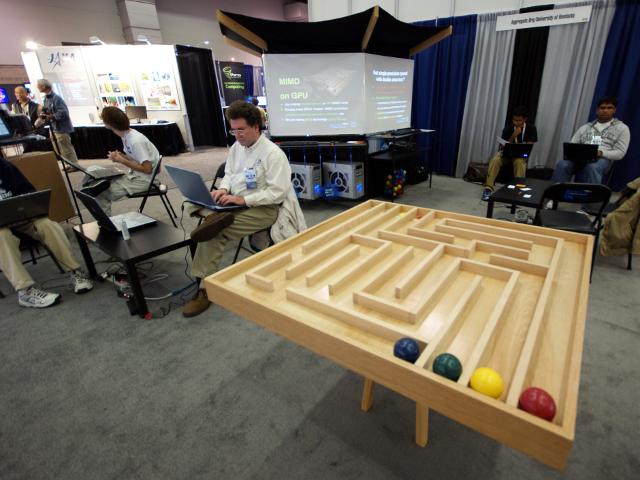
The maze
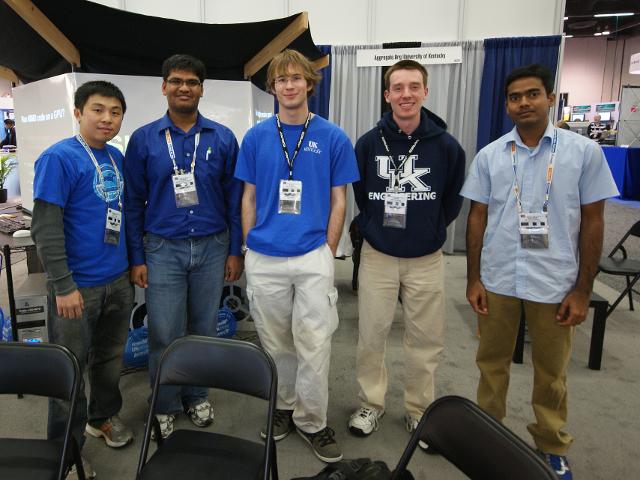
The student researchers in our booth this year
 The only thing set in stone is our name.
The only thing set in stone is our name.

